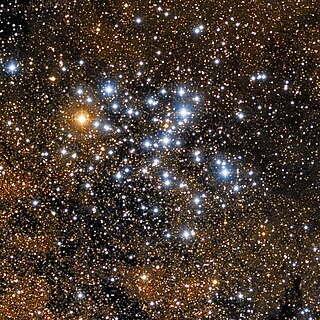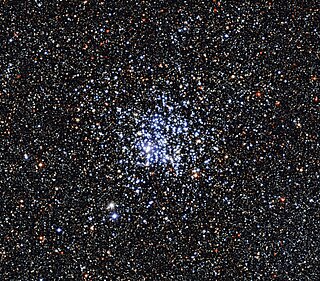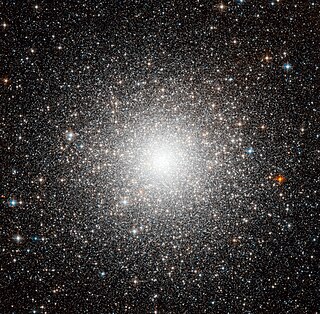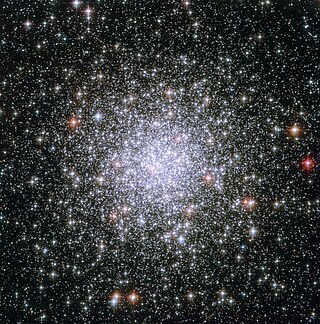
Below is a list of the largest known star clusters , ordered by diameter in light years, above the size of 50 light years in diameter. This list includes globular clusters, open clusters, super star clusters, and other types.

Below is a list of the largest known star clusters , ordered by diameter in light years, above the size of 50 light years in diameter. This list includes globular clusters, open clusters, super star clusters, and other types.
| Cluster name | Diameter (light-years) | Type of cluster | Notes |
|---|---|---|---|
| Terzan 7 | 316 [1] | Globular cluster | |
| Messier 54 | 306 [2] | ||
| NGC 339 | 238 [3] | ||
| Messier 3 | 226 [4] | ||
| Messier 11 (Wild Duck Cluster) | 190 [5] | Open cluster | |
| Messier 2 | 174.4 [6] | Globular cluster | |
| Omega Centauri | 172 ± 12 [7] | Largest globular cluster in the Milky Way. [8] | |
| Messier 13 | 168 [9] | ||
| Messier 15 | 166 [10] | ||
| Palomar 5 | 152 [11] | ||
| Messier 75 | 126 [12] | ||
| 47 Tucanae | 120 [13] | ||
| Messier 68 | 106 [14] | ||
| Messier 22 | 100 ± 10 [15] | One of the first star clusters ever discovered. [16] | |
| Messier 14 | 100 [15] | ||
| Messier 62 | 98 [17] | ||
| Messier 55 | 96 [18] | ||
| NGC 265 | 94 [19] | Open cluster | |
| Messier 69 | 90 [20] | Globular cluster | |
| Messier 9 | 90 [21] | ||
| Messier 56 | 84 [22] | ||
| Messier 10 | 83.2 [23] | ||
| NGC 3201 | 80 [24] | ||
| Messier 107 | 79 [25] | ||
| Messier 46 | 75.6 [26] | Open cluster | |
| Messier 4 | 75 [27] | Globular cluster | Nearest globular cluster to the Earth. Also the first globular cluster known to have exoplanets (PSR B1620-26b) |
| Messier 12 | 74.4 [28] | ||
| Messier 70 | 68 [29] | ||
| NGC 290 | 66 [30] | Open cluster | |
| Messier 28 | 60 [31] | Globular cluster | |
| Messier 18 | 52.4 [32] | Open cluster | |
| The following notable star clusters are listed for the purpose of comparison. | |||
| MGC1 | 49 (half-light), 7,800 (tidal) [33] | Globular cluster | |
| Mayall II | 42±1 (half-light), 526±25.4 (tidal) [34] | ||
| Pleiades | 40.68 [35] | Open cluster | Nearest Messier Object to Earth and the easiest to see in the night sky. |
| RSGC2 (Stephenson 2) | 26.1 [36] | ||
| Alpha Persei cluster | 22.8 [37] | ||
| Jewel Box | 20 [38] | ||
| Hyades | 17.6 [39] | Nearest open cluster | |
| Beehive Cluster (Praesepe) | 15 [40] | ||
| RSGC1 | 9.78 ± 1.96 [41] | ||
| Westerlund 1 (Ara Cluster) | 6.52 [42] | Super Star Cluster/Open cluster | |

Scutum is a small constellation. Its name is Latin for shield, and it was originally named Scutum Sobiescianum by Johannes Hevelius in 1684. Located just south of the celestial equator, its four brightest stars form a narrow diamond shape. It is one of the 88 IAU designated constellations defined in 1922.

Messier 2 or M2 is a globular cluster in the constellation Aquarius, five degrees north of the star Beta Aquarii. It was discovered by Jean-Dominique Maraldi in 1746, and is one of the largest known globular clusters.

The Butterfly Cluster is an open cluster of stars in the southern constellation of Scorpius. Its name derives from the vague resemblance of its shape to a butterfly. The Trumpler classification of II 3 r encodes it is rich in stars, ranks II out of IV for disparateness and greatly mixes bright with faint components. It is 3.5° to the northwest of Messier 7, both north of the tail of Scorpius.

Messier 10 or M10 is a globular cluster of stars in the equatorial constellation of Ophiuchus. The object was discovered by the French astronomer Charles Messier on May 29, 1764, who cataloged it as number 10 in his catalogue and described it as a "nebula without stars". In 1774, German astronomer Johann Elert Bode likewise called it a "nebulous patch without stars; very pale". Using larger instrumentation, German-born astronomer William Herschel was able to resolve the cluster into its individual members. He described it as a "beautiful cluster of extremely compressed stars". William Parsons, 3rd Earl of Rosse thought he could distinguish a dark lane through part of the cluster. The first to estimate the distance to the cluster was Harlow Shapley, although his derivation of 33,000 light years was much further than the modern value.

The Wild Duck Cluster is an open cluster of stars in the constellation Scutum. It was discovered by Gottfried Kirch in 1681. Charles Messier included it in his catalogue of diffuse objects in 1764. Its popular name derives from the brighter stars forming a triangle which could resemble a flying flock of ducks. The cluster is located just to the east of the Scutum Star Cloud midpoint.

Messier 28 or M28, also known as NGC 6626, is a globular cluster of stars in the center-west of Sagittarius. It was discovered by French astronomer Charles Messier in 1764. He briefly described it as a "nebula containing no star... round, seen with difficulty in 31⁄2-foot telescope; Diam 2′."

Messier 54 is a globular cluster in the constellation Sagittarius. It was discovered by Charles Messier in 1778 and then included in his catalog of comet-like objects.

Messier 55 is a globular cluster in the south of the constellation Sagittarius. It was discovered by Nicolas Louis de Lacaille in 1752 while observing from what today is South Africa. Starting in 1754, Charles Messier made several attempts to find this object from Paris but its low declination meant from there it rises daily very little above the horizon, hampering observation. He observed and catalogued it in 1778. The cluster can be seen with 50 mm binoculars; resolving individual stars needs a medium-sized telescope.

Messier 56 is a globular cluster in the constellation Lyra. It was discovered by Charles Messier in 1779. It is angularly found about midway between Albireo and Sulafat. In a good night sky it is tricky to find with large (50–80 mm) binoculars, appearing as a slightly fuzzy star. The cluster can be resolved using a telescope with an aperture of 8 in (20 cm) or larger.

Messier 62 or M62, also known as NGC 6266 or the Flickering Globular Cluster, is a globular cluster of stars in the south of the equatorial constellation of Ophiuchus. It was discovered in 1771 by Charles Messier, then added to his catalogue eight years later.

Messier 68 is a globular cluster found in the east south-east of Hydra, away from its precisely equatorial part. It was discovered by Charles Messier in 1780. William Herschel described it as "a beautiful cluster of stars, extremely rich, and so compressed that most of the stars are blended together". His son John noted that it was "all clearly resolved into stars of 12th magnitude, very loose and ragged at the borders".

Messier 69 or M69, also known NGC 6637, is a globular cluster in the southern constellation of Sagittarius. It can be found 2.5° to the northeast of the star Epsilon Sagittarii and is dimly visible in 50 mm aperture binoculars. The cluster was discovered by Charles Messier on August 31, 1780, the same night he discovered M70. At the time, he was searching for an object described by Nicolas-Louis de Lacaille in 1751–2 and thought he had rediscovered it, but it is unclear if Lacaille actually described M69.

Messier 75 or M75, also known as NGC 6864, is a giant globular cluster of stars in the southern constellation Sagittarius. It was discovered by Pierre Méchain in 1780 and included in Charles Messier's catalog of comet-like objects that same year.

G Scorpii, also named Fuyue, is a giant star in the constellation of Scorpius. It has an apparent magnitude of +3.19. It is approximately 126 light-years from the Sun.

NGC 3201 is a low galactic latitude globular cluster in the southern constellation of Vela. It has a very low central concentration of stars. This cluster was discovered by James Dunlop on May 28, 1826 and listed in his 1827 catalogue. He described it as "a pretty large pretty bright round nebula, 4′ or 5′ diameter, very gradually condensed towards the centre, easily resolved into stars; the figure is rather irregular, and the stars are considerably scattered on the south".

27 Vulpeculae is a single, blue-white star in the northern constellation of Vulpecula. It is a dim star, visible to the naked eye, with an apparent visual magnitude of 5.59. An annual parallax shift of 10.6692±0.0483 mas provides a distance estimate of about 306 light-years. It is moving closer with a heliocentric radial velocity of −22 km/s, and will make perihelion passage at a distance of around 119 ly (36.56 pc) in 3.75 million years.

NGC 6441 is a globular cluster in the southern constellation of Scorpius. It was discovered by the Scottish astronomer James Dunlop on May 13, 1826, who described it as "a small, well-defined rather bright nebula, about 20″ in diameter". The cluster is located 5 arc minutes east-northeast of the star G Scorpii, and is some 43,000 light-years from the Sun.

NGC 3311 is a super-giant elliptical galaxy located about 190 million light-years away in the constellation Hydra. The galaxy was discovered by astronomer John Herschel on March 30, 1835. NGC 3311 is the brightest member of the Hydra Cluster and forms a pair with NGC 3309 which along with NGC 3311, dominate the central region of the Hydra Cluster.

NGC 708 is an elliptical galaxy located 240 million light-years away in the constellation Andromeda and was discovered by astronomer William Herschel on September 21, 1786. It is classified as a cD galaxy and is the brightest member of Abell 262. NGC 708 is a weak FR I radio galaxy and is also classified as a type 2 Seyfert galaxy.